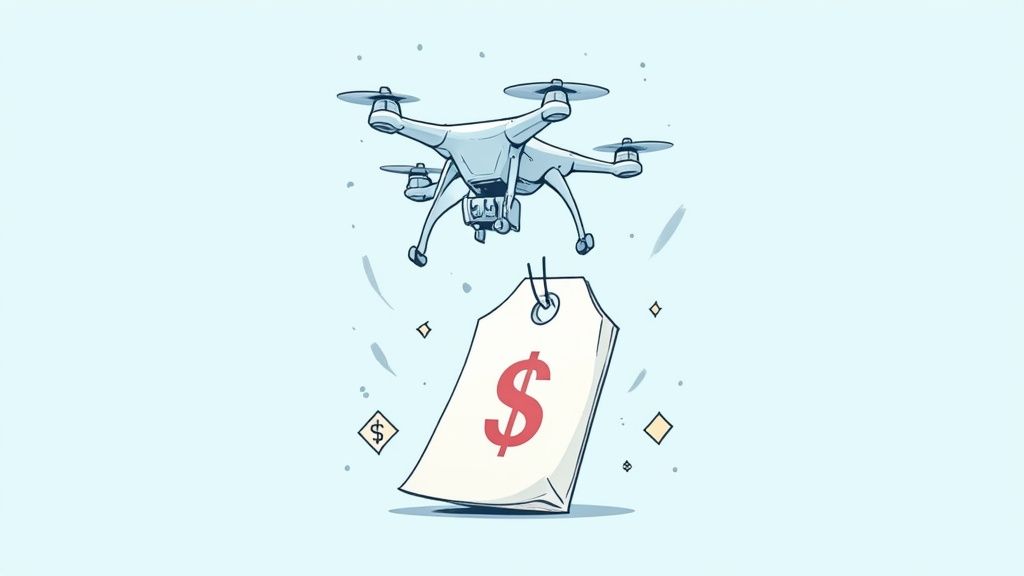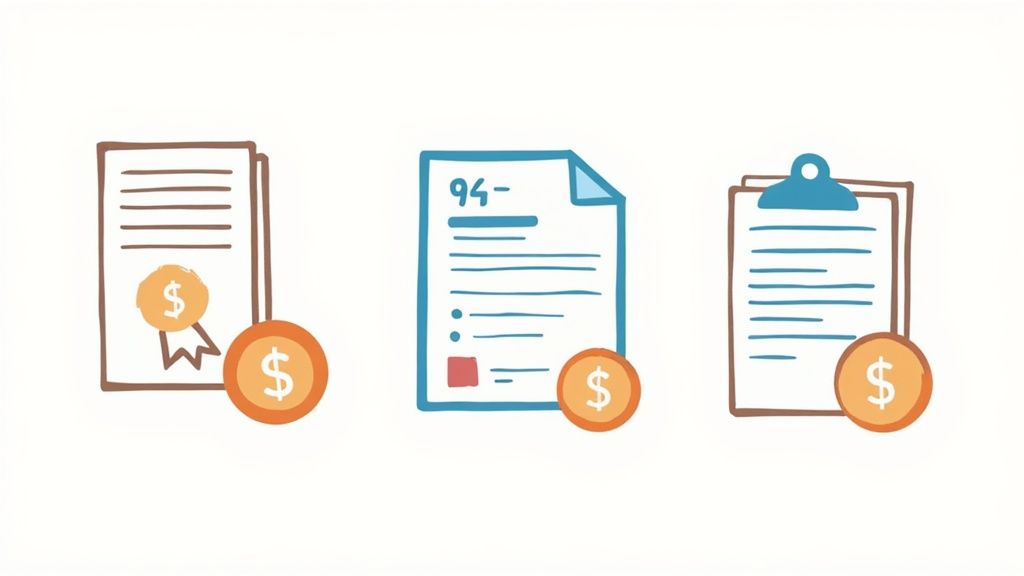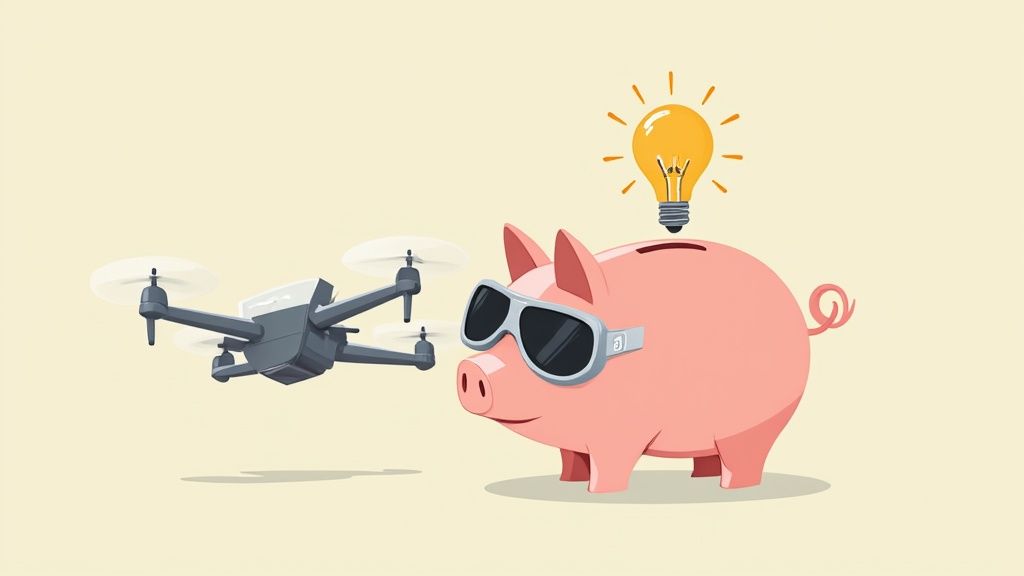Drone Pilot License Cost: What You Need to Know
- A.E. Williams

- May 15
- 10 min read
Updated: May 20
Navigating Drone License Requirements Without Confusion

Understanding drone license requirements is essential for anyone wanting to fly. It's important to differentiate between recreational and commercial drone use, as each has specific legal obligations. Recreational flying generally has fewer restrictions, often allowing hobbyists to fly without extensive certifications. However, commercial drone operations require stricter adherence to regulations, primarily for safety and airspace management.
This difference exists because of the higher risks associated with commercial drone activities. These often involve flying over populated areas or critical infrastructure. As a result, the drone pilot license cost and requirements differ significantly between these two categories.
Recreational Vs. Commercial Drone Use
The key difference between recreational and commercial drone use lies in the purpose of the flight. Flying for fun, taking personal videos, or simply exploring your surroundings is usually considered recreational. On the other hand, any drone operation for profit or business is commercial.
This includes activities like aerial photography for real estate, infrastructure inspections, or agricultural surveys. Even seemingly small commercial uses, such as delivering small packages or capturing aerial footage for local news, require the proper licensing. Therefore, understanding your intended use is the first step in figuring out your licensing needs. You might be interested in: our sitemap for more blog categories.
Understanding the FAA Part 107
In the United States, commercial drone pilots need a Part 107 certificate from the Federal Aviation Administration (FAA). Grasping the regulatory environment is key. Want to learn more? Check out this helpful resource on the FAA Part 107 Drone Landscape. The $175 FAA Part 107 exam is a significant initial investment for aspiring commercial drone pilots.
This exam covers crucial topics like airspace classifications, weather conditions, and drone regulations. Preparing for the exam can also incur costs, with test prep courses sometimes costing several hundred dollars. However, discounts may be available through partnerships, like Spexi's collaboration with UAV Coach, offering a $100 discount. The cost reflects the importance of well-trained drone pilots operating safely and legally. Find more statistics here. Remember, there may also be recurring costs for license renewals and continuing education.
International Drone Regulations
Drone regulations and licensing costs aren't unique to the U.S. Every country has its own rules for drone operations, each with different requirements and costs. Aspiring international drone pilots must research and understand local regulations to avoid penalties.
Some countries may have agreements with the FAA, allowing U.S.-certified pilots to operate under their existing certification. Often, though, a separate license is necessary for each country, increasing the overall drone pilot license cost. This complexity emphasizes the need for thorough planning and research for international drone operations.
The True Cost of FAA Part 107 Certification
Obtaining your FAA Part 107 certification involves more than just the exam fee. It's essential to understand all the costs associated with becoming a certified drone pilot. This includes the obvious expenses and hidden costs that can impact your budget. Planning for these expenses upfront will ensure a smoother transition to becoming a certified remote pilot.
Breaking Down the Expenses
The most apparent cost is the $175 FAA Part 107 exam fee. This non-negotiable expense covers the administration and grading of the exam. However, preparing for the exam often involves additional investments.
Study materials, like textbooks, online courses, and practice exams, can range from $50 to $300 or more. Choosing the right study materials that fit your learning style is a crucial step in preparing for the exam.
Consider the cost of travel to a testing center. Depending on your location, this could involve transportation, accommodation, and meals. While some pilots can test locally, others might need to travel, increasing the overall expense.

This infographic compares the average costs of three drone license types: recreational, commercial (Part 107), and enterprise. The Part 107 commercial license sits in the middle cost-wise, significantly higher than recreational but less than specialized enterprise licenses. This highlights the investment required for commercial operation while showing the potential for higher costs with more specialized certifications.
To help break down these costs, let's look at a detailed table:
FAA Part 107 Certification Cost Breakdown
A comprehensive breakdown of all costs associated with obtaining and maintaining an FAA Part 107 drone pilot license.
This table provides a clear overview of the expenses involved in obtaining and maintaining your Part 107 license. Remember to factor in these recurring costs when planning your drone operations budget.
Beyond the Initial Certification
After obtaining your Part 107 certificate, factor ongoing costs into your budget. The certificate is valid for two years, after which you'll need to complete a recurrent knowledge test for renewal. This recurring cost is crucial for staying current with regulations and maintaining your certification.
If you use your certification for business, other expenses arise. These can include insurance, equipment maintenance, marketing, and potential software subscriptions. These recurring costs are often overlooked but essential for successful commercial drone operations.
Budgeting for Success
Successfully budgeting for your drone pilot license requires considering both initial and ongoing expenses. Creating a comprehensive budget can help you track spending and ensure you're prepared for the long-term costs of maintaining your certification. This financial planning is essential for a successful and sustainable career as a certified drone pilot.
Training Options That Deliver Real Value
Not all drone pilot training programs are created equal. Some offer exceptional value and fully prepare you for the FAA Part 107 exam, while others may leave you wanting. Evaluating these options based on exam pass rates and career outcomes can help you make an informed decision. Let's explore the spectrum, from free self-study resources to intensive boot camps costing thousands of dollars.
Self-Study vs. Instructor-Led Training
Self-study, utilizing free online resources or budget-friendly study guides, is appealing to cost-conscious aspiring pilots. However, it demands discipline and self-motivation. This method might be best for individuals who thrive learning independently and managing their own study schedules.
Instructor-led training, whether online or in-person, offers structured learning and expert guidance. This can be invaluable for those who prefer a more structured environment and benefit from direct interaction with instructors and peers. However, these programs typically come at a higher drone pilot license cost.
Hybrid Approaches: Balancing Cost and Effectiveness
Hybrid approaches, blending self-study with targeted professional instruction, often offer the best of both worlds. This approach lets you learn the fundamentals independently and then leverage expert guidance for more challenging concepts or exam strategies. It often represents excellent value, maximizing your training investment.
Identifying Quality Training Programs
Regardless of your chosen path, choosing a quality program is crucial. Look for programs with high exam pass rates, positive student reviews, and comprehensive curriculums covering all aspects of the Part 107 exam. Consider the support offered, like access to instructors, practice exams, and updated study materials. You might be interested in: our event page sitemap.

Industry Trends and Drone Pilot Demand
The drone pilot license cost is part of a bigger economic picture. Despite recent declines in drone industry funding, demand for certified pilots remains steady. This is partly due to the growing use of drones in real estate, construction, and energy. Explore this topic further here. This increasing demand highlights the importance of selecting a training program that prepares you for success in this expanding field. While licensing costs remain relatively stable, other costs, such as drone purchase and maintenance, can fluctuate based on technology and use. Understanding these trends is key to making a wise investment in your drone piloting career. One resource for understanding business costs is Shopify's blog post on selling costs.
Global License Costs: What You'll Pay Worldwide
Drone regulations are different all over the world, and so are the costs. Knowing the financial side of drone licensing in different countries is important for both recreational and commercial pilots. This section looks at how different regulations affect drone pilot license costs, both upfront and ongoing.
Navigating International Drone Regulations
Many countries base their drone rules on those from the European Union Aviation Safety Agency (EASA) or the Federal Aviation Administration (FAA) in the United States. But, the specific requirements and costs can be very different. For example, some countries may require specific training or flight tests that others don't. This can add a lot to the total cost.
The cost of the drone itself is also a factor. Across the world, the cost of getting a drone pilot license can vary significantly. The U.S. has a simple exam fee, but other countries might have different requirements and costs. For example, EASA rules require training and a license, but costs can be different within the EU. Drone prices also vary widely, from a few hundred dollars to tens of thousands for professional models. As the drone industry grows, license costs will continue to be a key factor for potential pilots. Learn more about drone costs here. Researching local rules and costs is important before getting a license anywhere.
Comparing Costs Across Different Regions
Understanding the range of costs helps pilots make good decisions. Some countries have less expensive licensing processes than others.
To help illustrate the differences, let's take a look at the table below:
International Drone License Cost Comparison
This table provides a simplified overview. Actual costs can be different. Always check official sources for the most current information.
Reciprocity Agreements and International Operations
For pilots working in different countries, reciprocity agreements can be helpful. These agreements can simplify licensing and potentially lower costs by letting pilots use their current certifications in other countries. But, these agreements aren't everywhere, and pilots need to check the specific rules.
Emerging Trends in International Drone Regulation
International drone regulations are always changing to keep up with technology and safety. These changes can affect future drone pilot license costs and create new requirements.
For instance, some countries are shifting to performance-based regulations. These focus on the safety of drone flights rather than strict rules. This could lead to new licenses based on specific drone operations or risk levels. Staying updated on these trends is key for anyone wanting a drone pilot license, so they are ready for the changing rules. You can explore more topics on our blog posts sitemap.
Hidden Expenses Every Drone Pilot Should Anticipate

Getting your drone pilot license is a big step, but the costs don't stop there. Understanding the hidden expenses is key to budgeting and creating a sustainable drone operation. This section explores often-overlooked costs for aspiring and current drone pilots.
Essential Equipment: Beyond The Drone Itself
Most people focus on the drone's price, which can vary widely. However, essential accessories are often forgotten. These include extra batteries, propellers, a carrying case, and possibly specialized lenses or sensors. For example, a professional photographer might need high-quality lenses, adding to the overall drone pilot license cost.
Maintenance And Repairs: The Ongoing Investment
Drones require regular maintenance and occasional repairs, just like any aircraft. This includes routine cleaning, part replacements, and potentially major repairs after crashes or malfunctions. Budgeting for these inevitable costs prevents unexpected financial burdens.
Insurance: Protecting Your Investment And Business
Insurance is crucial but often underestimated. Liability insurance protects you from damage caused by your drone, while hull insurance covers damage to the drone itself. Policy costs depend on your coverage needs and the type of drone operations you conduct.
Marketing And Business Development: Reaching Your Clients
For commercial drone pilots, marketing is essential for client acquisition. This includes website development, online advertising, social media promotion, and industry networking. These expenses are crucial for a successful drone business.
Staying Current: Renewals And Continuing Education
Drone regulations constantly change. Staying updated requires ongoing learning and potential license renewal fees. This recurring drone pilot license cost ensures compliance and maintains your competitive edge. You can find more information on this and related topics on our blog post sitemap.
Software And Subscriptions: Enhancing Your Operations
Specialized software for flight planning, photo editing, or data analysis can improve your drone operations. These often involve subscription fees that should be factored into your budget.
Building A Comprehensive Budget
A comprehensive budget accounting for all these hidden expenses is essential for successful drone operations. Consider equipment depreciation, potential upgrades, and seasonal revenue fluctuations. This proactive planning sets you up for long-term success.
Calculating Your ROI: When Does Licensing Pay Off?
Investing in a drone pilot license represents a significant financial commitment, opening doors to exciting new income opportunities. But how can you determine if it's the right choice for your circumstances? The key lies in understanding the drone pilot license cost compared to your potential earnings. This requires a careful analysis of the return on investment (ROI) within different drone service niches.
Assessing ROI Across Different Drone Service Niches
The potential ROI for a drone pilot license can vary greatly depending on your chosen specialization. For instance, real estate photography often yields quicker returns. This is due to consistent demand and relatively low startup costs compared to a field like industrial inspection, which demands more specialized equipment and often carries higher insurance premiums. Agricultural monitoring and event coverage each present unique cost and revenue structures, influencing the time it takes to recoup your initial investment and achieve profitability. For more information, check out our sitemap of our pages.
Real-World Examples: Case Studies of Drone Businesses
Examining real-world case studies provides valuable context. Let's compare the potential journeys of a new real estate photographer and a seasoned industrial inspector. The photographer might recoup their drone pilot license cost in a matter of months, assuming favorable market rates and effective client acquisition. The inspector, despite commanding higher fees, might face a longer ROI timeline due to the upfront investment in advanced equipment and specialized training.
Factors Influencing ROI: Market Rates, Client Acquisition, Service Evolution
Local market rates significantly impact how quickly you can recover your investment. Premium rates for specialized services like LiDAR surveys can accelerate ROI. Conversely, highly competitive fields like basic aerial photography may experience pricing pressure, potentially slowing down returns. Client acquisition strategies also play a crucial role. Cost-effective approaches like word-of-mouth referrals or strategic partnerships can maximize profit margins and shorten the ROI timeline. Finally, successful drone pilots continually adapt their services. Offering value-added services like 3D modeling or thermal imaging differentiates you from competitors and justifies premium pricing, boosting your bottom line.
Decision Frameworks: Evaluating Certification's Financial Alignment
To determine if certification aligns with your financial goals, establish a clear decision framework. This includes:
Estimating startup costs: Factor in the drone pilot license cost, equipment, insurance, and initial marketing expenses.
Projecting potential revenue: Research market rates for your target services and develop realistic client acquisition estimates.
Calculating break-even point: Determine the number of jobs or clients required to cover expenses and start generating profit.
Analyzing potential risks: Consider factors like competition, regulatory changes, and equipment malfunctions that could impact your earnings.
By carefully considering these factors, you can make a well-informed decision about pursuing drone pilot certification and set realistic financial expectations. Ready to elevate your drone piloting passion? Visit JAB Drone to explore the latest drone technology, in-depth reviews, and expert insights.




Comments